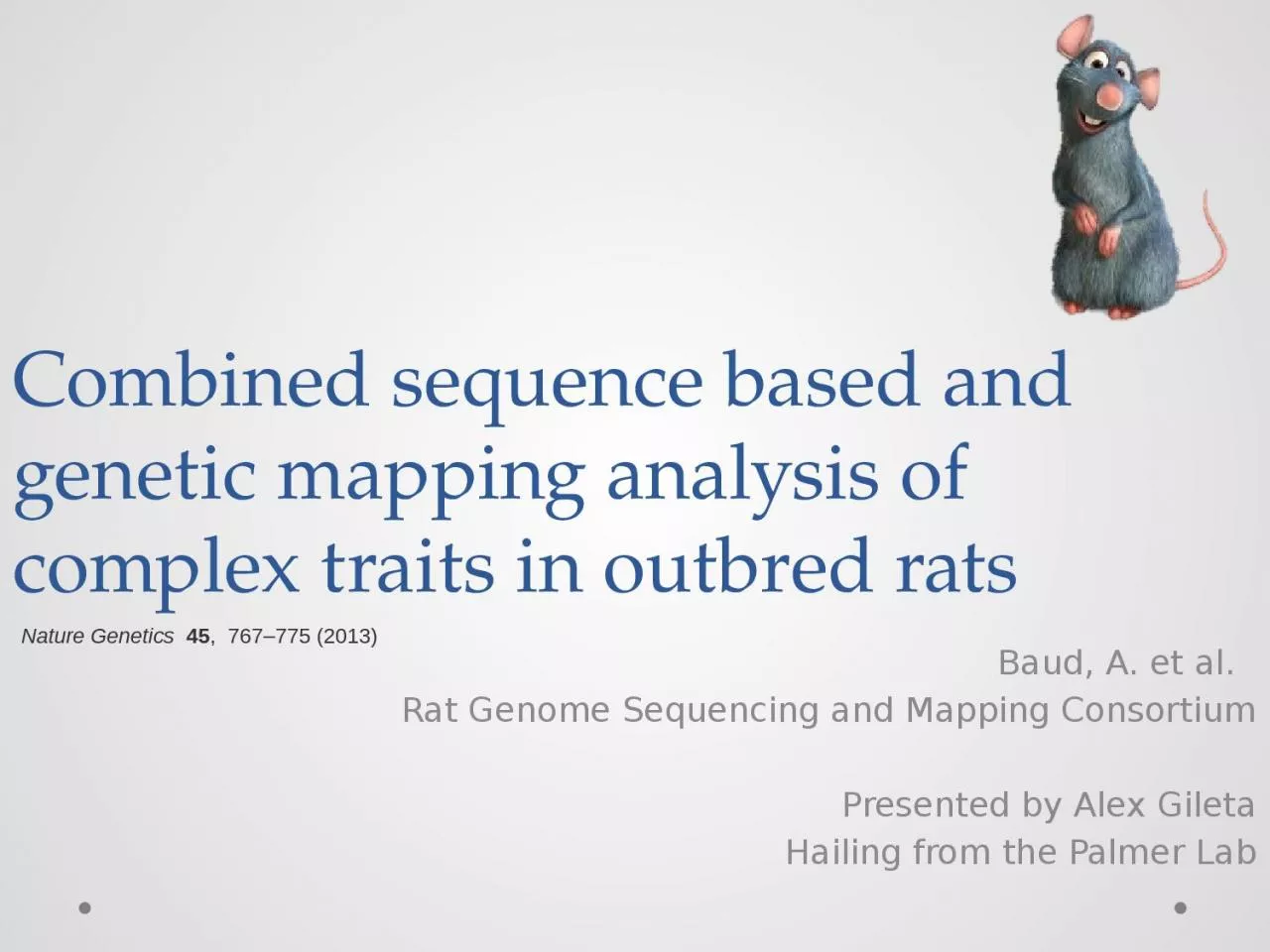

Baud A et al Rat Genome Sequencing and Mapping Consortium Presented by Alex Gileta Hailing from the Palmer Lab Nature Genetics 45 767775 2013 Genetic Variation and Complex Traits ID: 1047308
Download Presentation The PPT/PDF document "Combined sequence based and genetic mapp..." is the property of its rightful owner. Permission is granted to download and print the materials on this web site for personal, non-commercial use only, and to display it on your personal computer provided you do not modify the materials and that you retain all copyright notices contained in the materials. By downloading content from our website, you accept the terms of this agreement.
1. Combined sequence based and genetic mapping analysis of complex traits in outbred rats Baud, A. et al. Rat Genome Sequencing and Mapping ConsortiumPresented by Alex GiletaHailing from the Palmer LabNature Genetics 45, 767–775 (2013)
2. Genetic Variation and Complex Traits
3. QTL MappingNature Reviews Genetics 10, 565-577 (August 2009)
4. ImputationNature Reviews Genetics 11, 499-511 (July 2010)
5. Issues with GWAS in HumansIncreasingly large sample sizesSmall effect sizesRare variantsInaccessible disease-relevant tissuesEnvironmental variationNo potential for functional characterizationManolio et al. Nature 461, 747-753
6. Model System SolutionsSmall sample sizesAccessible disease-relevant tissuesNo environmental variationNo rare variantsEasily genetically manipulatedLargely syntenicBrudno M et al. Genome Res. 2004;14:685-692Cold Spring Harbor Laboratory PressExon-based map of conserved synteny between the rat, human, and mouse genomes.
7. Mice vs RatsSmaller/cheaperHistoric ease of genetic manipulationWell studiedLargerPhenotypingSurgeryTissue Samples“Smarter”DocileHeart rateDrug metabolismGenome size (2.75)HS stocks homogeneousHistoryDisease overlap with humans
8. http://openwetware.org/images/1/1f/AmelieBaud_RatHS.pdfThe rat Heterogeneous StockQTLs down to 1Mb levelAccuracy of imputationWell-defined haplotype space
9. Paired-end SOLiD sequencing – 8 founders> 22x Coverage
10. 7.2 million SNPs, 633k indels, 44k structural variantsFalse pos/neg rates:SNP – 2.7% & 17.2%Indels – 2.2% & 16.7%Structural – 16.7% & 65%
11.
12. Genotyping ArrayRATDIVReduced representation sequencing with REs803,485 SNPs chosen from a pilot utilizing 2.1 million SNPs from 13 inbred lines (none from HS)560,000 passed QC in foundersSOLiD vs RATDIV – 99.98% concurrenceGenotyped 1407 HS rats265,551 markers used for mappingDiscarded for standard QC, if monomorphic over all founders, or if founder was heterozygous.
13. Phenotypes
14. http://openwetware.org/images/1/1f/AmelieBaud_RatHS.pdfSingle-point vs. Haplotypic Mapping
15. QTL Mapping in HSVarying relatedness in HSSiblings, half-sibs, cousins, etc.Mixed ModelsAssume trait is normally distributedGenotypic similarity matrixResample Model AveragingNon-parametic (binary, negative binomial)Consistency across multiple QTL modelsFitted on subsamples of the mapping population (like bootstrapping)Haplotype association R HAPPYDescent probabilities averaged over 90kb windows
16. Mixed Model - Haplotypey = phenotypic value of rat iβ = regression coefficient for covariate cx= covariate value of c for rat iT = effect size of one copy of a given haplotype from strain s at locus LP = expected number of haplotypes of type s carried by rat i at locus L U – random genetic effectsΕ – random errorUi – contains genetic covariance matrixEstimated by IBSEstimating TStandard linear model after transformation
17. QTL Mapping ResultsResample and Mixed Model355 QTLs in 122 phenotypesExplained on average 5-6.5% of phenotypic varianceSkewed distributionQTLs explained 42% of heritable variation on averageConfidence interval – median of 4.5 Mb~40 genes
18. Assume single variant is causal (1) Is the variant associated with the phenotype? standard test of association(2) Is its association as significant as the association in the haplotype-based test in the locality of the variant?Models are nested, should be comparableSignificance will be greater – fewer degrees of freedom Calculate d = max log(P.merge) – max log(P.hap)Can’t distinguish SNPs with identical distributionSignificance of haplotype comes from genome-wide test, SNP from only within the QTL?Merge Analysis
19. Merge AnalysisB. Yalcin, J. Flint, & R. Mott - Genetics 171: 673–681 (October 2005)
20. Why do merge analysis?Rules out causal role for majority of variants90%+Identifies some candidates in coding regionsEliminates genes far from candidate variants
21. Rules out causal role for majority of variants131/343 (38%) of QTLs had candidate variants28 single gene with candidateCTNND2Shank2Only candidate variant in 82 genes within QTL
22. Identifies some candidates in coding regionsIdentifies some candidates in coding regions
23. Merge Analysis: Not Enough? 212 QTLs (62%) w/o candidate variantsWhy so few?(1) Causative variant not sequencedTest all SDPs by merge analysisOnly 44/212, leaving 168 (49%) (2) Haplotype mapping biased towards QTLs lacking single causal variantsSimulations to test 3 scenariosSingleMultipleHaplotypeWhat about at QTLs where a single variant is highly likely to be causal?Cis-eQTLs 1,398 hippocampus (97% found SCVs)7,464 Trans-eQTLs however…..hmm.
24. Merge Analysis: Not Enough? Why so few?(3) Haplotype test winner’s curse?Merge performs well in simulation, what about across genome?Merge 152 different than haplotype16% fewer overallOnly 9% w/o candidateCombined, 44% w/o single causal variant(4) Merge underestimates significance?Compare to single-marker test at genotyped SNPs0.9 r2 correlation between log(P)Should merge have unique results from haplotype?
25. Concordance Between SpeciesQTL overlap between mouse-HS and rat-HS?38 common measures/modelCD4+/CD8+ cell ratioKEGG Both were enriched for QTLs associated with B cells/total WBC pop.Sampling?
26. ConclusionsDiscovered 355 QTLs in 122 phenotypesTBX1 & ABCB10 – Nonsynonymous SNPsExonic Could alter protein function in T cell regulation and red blood cell differentiation respectivelyMedian explained heritability – joint QTLsRat – 39.1% / Mouse – 32.2% / Human – 10%Different allele frequency spectrums & # SNPsMerge analysis may help identify QTVsMany QTLs lack candidate variants (44%)Type loci in humans of QTLs discovered in rats?Rats are cool.
27. Thanks for Listening!Acknowledgements Matthew Stephens Abraham Palmer Peter Carbonetto Palmer LabGerald BotheShyam Gopalakrishnan GRTG Training GrantP50